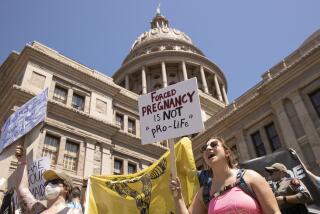Asbestos Study Provides Clues to Baby Fatalities
- Share via
WASHINGTON — Signs of asbestos were found in the lungs of nearly half of 15 babies who died of sudden infant death syndrome, indicating the babies may have had difficulty clearing foreign particles from their lungs, a recent study shows.
Autopsies of 46 infants in the Texas study showed about seven, or 46.6% of the 15 children who died of sudden infant death syndrome, had asbestos bodies in their lungs, compared to 9.7% of the 31 babies who died of other causes.
Sudden infant death syndrome, or SIDS, claims the lives of more than 6,000 babies annually in the United States, but the exact causes of the disease remain a mystery. Researchers suspect breathing problems may be involved, and the finding of asbestos bodies in the babies’ lungs supports this suspicion and may help explain the problem more precisely.
Asbestos bodies, considered a sign of exposure to asbestos, are an iron-protein complex secreted by cells to coat inhaled asbestos fibers.
Most of the infants studied were born and lived in the Galveston County, Tex., area and ranged in age from one month to 27 months.
Dr. Abida Haque of the University of Texas Medical Branch at Galveston, who conducted the study, said the asbestos levels found in SIDS babies’ lungs were relatively low and probably did not cause their deaths. But Haque said her findings provide evidence that the lungs of SIDS victims do not clear foreign particles as efficiently as other babies’ lungs.
Patterns of Difficulty
“We know that children who are prone to SIDS have patterns of difficult breathing during their sleep. It sort of makes sense that they are not able to clear materials through their lungs the same as normal children,” Haque said.
The pathologist said some theories on the cause of SIDS have suggested the infants have an underlying, abnormal lung physiology.
The three babies without SIDS who had asbestos bodies in their lungs all died of bronchopulmonary dysplasia--a disease of premature infants involving structural problems with the respiratory system.
No asbestos bodies were found in the lungs of children who died of pneumonia, brain injury or other causes.
Researchers said that in addition to physiological abnormalities, greater exposure to asbestos in the air or water may account for the asbestos bodies in the babies’ lungs.
Because of this possibility, Haque cautioned it is too early to generalize about asbestos in SIDS babies who die in other geographic regions.
But the pathologist added, “I am leaning more toward thinking that all children are exposed to asbestos from whatever source, and those who cannot clear it as efficiently form asbestos bodies.”
Other Environmental Factors
Haque now plans to examine environmental factors surrounding babies that died with asbestos bodies in their lungs.
Dr. Marie Valdes-Dapena of the University of Miami’s medical school, commenting on the SIDS study, said, “This is in line with my thinking about what is wrong with these babies. I have had a feeling for a long time they don’t have a capacity to clear their lungs--that they are functioning as subtly handicapped children.”
Valdes-Dapena, an expert on SIDS babies, said the asbestos findings support current theories that there are slight physiological differences between healthy babies and those with SIDS.
More to Read
Sign up for Essential California
The most important California stories and recommendations in your inbox every morning.
You may occasionally receive promotional content from the Los Angeles Times.












